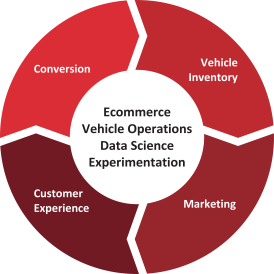The U.S. used automotive market is the largest consumer product category, generating approximately $841 billion from sales of approximately 40 million units in 2019. The industry is highly fragmented, with over 42,000 dealers and millions of peer-to-peer transactions. But the industry still needs to rely more on an outdated dealership model.
The traditional dealership model involves limited selection, lack of transparency, high-pressure sales tactics, and inconvenient hours. These shortcomings have caused many consumers to circumvent the dealer and transact independently, creating a large peer-to-peer market for used vehicles.
However, the peer-to-peer market comes with its own set of challenges for both buyers and sellers, entailing home visits by strangers, lack of secure payment methods or identity checks, difficulty researching available vehicles, and lack of verified vehicle conditions.
Presented with these alternatives, most consumers are dissatisfied with the current automotive buying and selling experience. Additionally, E-commerce Penetration in the U.S. Used Automotive Market is Just Beginning and is poised to grow.
Purchasing a used vehicle enables a consumer to obtain a fully reconditioned vehicle at a higher standard of luxury or with highly sought-after features for the same dollar amount as a new, lesser-model vehicle. In this shifting market, Used is the new “New.”
Vroom is an end-to-end eCommerce platform for used vehicles that offers a better way to buy and a better way to sell used vehicles. In this strategy story, we will analyze the business model of Vroom and how does Vroom work and make money.
What is Vroom? How does Vroom work?
Vroom, founded in 2013, is a New York City-based used car retailer and e-commerce company that lets consumers buy, sell, and finance cars online. Vroom takes a vertically integrated, hybrid asset-light approach, leveraging the benefits of national scale and local efficiency, reinventing all vehicle buying and selling phases, from discovery to delivery and everything in between. Vroom’s platform encompasses
E-commerce: In contrast to legacy dealerships and the peer-to-peer market, Vroom provides consumers with a personalized eCommerce interface to research and select from thousands of fully reconditioned vehicles. Vroom offers transparent pricing, real-time financing, and nationwide contact-free delivery to buyers. To sellers, Vroom provides attractive market-based pricing, real-time price quotes, and convenient, at-home vehicle pick-up.
Vehicle Operations: Vroom’s scalable and vertically integrated operations underpin Vroom’s business model. Vroom strategically sources inventory from consumers, auctions, rental car companies, original equipment manufacturers (“OEMs”), and dealers.
In Vroom’s reconditioning and logistics operations, Vroom deploys an asset-light strategy that optimizes a combination of ownership and operation of assets by it with strategic third-party partnerships.
As Vroom scales nationally, it continues to leverage Vroom’s expanding last-mile logistics operations and geographically dispersed network of reconditioning centers to develop Vroom’s regional operating model further.
Vroom’s inventory assortment and pricing models ingest millions of data points daily as it monitors, calibrates, and adjusts its inventory position to fluctuations in the national market and within its eCommerce platform, including predicted sales performance and real-time customer demand and conversion.
Data Science and Experimentation: Vroom relies on data science, machine learning, A/B, and multivariate testing to continually drive optimization and operating leverage across Vroom’s eCommerce and vehicle operations.

How does Vroom work for buyers?
- Browsing Vroom’s Inventory: Vroom’s platform allows customers to browse an inventory of thousands of vehicles and filter by make, model, mileage, color, and other factors.
- Purchase process: Following vehicle selection, customers promptly receive a call from a member of Vroom’s customer experience team to answer any questions and to help the customer finalize the transaction.
- Selecting Value-Added Products: As the customer completes the purchase process, the customer experience representative explains the value-added product options, including extended warranty and insurance policies.
- Getting Delivered: The last step in the customer journey involves arranging vehicle delivery. Customers select the location and timing of delivery along with any specific delivery instructions, and Vroom arranges the delivery with its network of third-party carriers.
How does Vroom work for Sellers?
- Sellers describe cars: Sellers start by providing a VIN. From there, the customer confirms or updates information about the vehicle, including information such as make, model, and mileage. Vroom’s data analytics tools appraise the value of a vehicle based on the answers provided.
- Sellers Get Offer: Upon receiving a customer’s application for an appraisal, Vroom runs the vehicle information through Vroom’s central vehicle database to generate a competitive appraisal based on market demand, estimated reconditioning costs, depreciation, and other factors that impact the retail and wholesale value of the vehicle.
- Vroom Picks It Up, and sellers Get Paid: After a customer has accepted Vroom’s purchase offer on their vehicle, a customer can arrange payment and at-home vehicle pick-up free of charge, using Vroom’s network of third-party logistics operators.
How does Vroom make money? What is the business model of Vroom?
Value Proposition
For Buyers
- Enormous Selection of Inventory: By making purchasing decisions based on data rather than intuition, Vroom can offer a wide selection of vehicles that excite Vroom’s customers.
- Consistent High Quality: All of Vroom’s vehicles pass Vroom’s detailed inspections and meet Vroom’s proprietary Vroom Reconditioning Standards, which result in high-quality used vehicles.
- Comprehensive and Transparent Vehicle Information: Vroom eliminates bait-and-switch risk through high-resolution photography and detailed product descriptions on Vroom’s platform, which show Vroom’s customers every aspect of Vroom’s vehicles from all angles, and provide third-party vehicle history reports on all of Vroom’s vehicles.
- Market-based Pricing: Vroom prices its vehicles using data science and algorithms, ensuring that buyers receive attractive, market-based, no-haggle pricing. Vroom’s pricing strategy considers hundreds of variables when determining the accurate market price of a vehicle, which are unavailable to traditional dealerships.
- On-Demand Shopping and Contact-Free, Convenient Delivery Experience: Vroom offers customers the ability to shop for their desired vehicle from any location. Vroom also delivers vehicles to customers of their choosing.
How CARS24 is leveraging technology to encourage online buying of cars
For Sellers
- Ease of Use: Sellers are not required to visit a dealership, and there is no cost to submit a vehicle for sale.
- On-Demand Appraisals: Vroom utilizes its extensive data insights and experience across thousands of transactions to generate a purchase offer that reflects a competitive market-based price, providing customers with a fast and easy customer experience.
- No High-Pressure Tactics: Vroom keeps all purchase offers open for two days or 250 miles. This process allows customers to shop, compare and analyze the sale of their vehicle from the convenience of their home to ensure they are getting the best value, eliminating pressure to take a deal on the spot.
- Contact-Free Vehicle Pick-ups: Vroom’s customers enjoy the convenience of national, at-home contact-free vehicle pick-ups free of charge within days of accepting Vroom’s offer.
How does Carvana make money: Business Model & Competitor Analysis
Marketing Strategy of Vroom
Vroom operates a multi-channel marketing strategy that includes both national brand and digital performance marketing. Vroom leverages various digital performance channels, including automotive aggregator sites, to generate demand for Vroom inventory by VIN.
Vroom also runs a national brand campaign through TV and online media. Vroom has more than doubled the total brand leads to Vroom’s website, which means a customer began their journey by going straight to Vroom’s website, meaningfully increasing Vroom’s sales mix of direct brand leads.
Because brand leads convert at a higher rate than all other marketing channels, Vroom believes that the continued growth of the national brand marketing campaign and an increasing mix of brand leads will improve Vroom’s marketing efficiency.
Vroom analyzes visitor traffic and customer interaction with its platform to identify and correlate visitor behavior with sales conversion. Vroom’s analytics enables it to measure and monitor the ROI generated by Vroom’s marketing placements, which it then uses to optimize placement and spending across marketing channels to balance sales velocity and profitability.
How does Vroom make money?
Vroom made $3.2 billion in 2021. The business model of Vroom makes money through the sale of used vehicles and value-added products. Vroom sells vehicles directly to consumers primarily through Vroom’s Ecommerce segment as a licensed dealer and through wholesale channels, which provide a revenue source for vehicles that do not meet Vroom’s Vroom retail sales criteria. Additionally, Vroom makes money through the retail sale of used vehicles and value-added products at Houston-based Texas Direct Auto or TDA.
Retail Vehicle Revenue: Vroom sells vehicles through its eCommerce platform and TDA. Retail vehicle revenue includes vehicle sales and delivery charges (if any). Retail sales made up 80% of the revenue generated by Vroom in 2021.
Wholesale vehicle revenue: Vroom sells vehicles that do not meet its Vroom retail sales criteria through wholesale channels. Vehicles sold through wholesale channels are acquired from customers who trade in their vehicles when purchasing from Vroom, from customers who sell their vehicles to Vroom in straight-buy transactions, and from the liquidation of vehicles previously listed for retail sale. Wholesales made up 16% of the revenue generated by Vroom in 2021.
Product revenue: Vroom generates revenue by earning fees on sales of value-added products to its customers in connection with vehicle sales, such as fees earned on customer vehicle financing from third-party lenders and fees earned on sales of other value-added products, such as vehicle service contracts, GAP protection, and tire and wheel coverage.
Other revenue: Other revenue consists of labor and parts revenue for vehicle repair services at TDA and, commencing in the first quarter of 2021, revenue from CarStory.
| Revenue (in $ thousand) | 2021 | 2020 | 2019 |
| Retail vehicle, net | 2,583,417 | 1,072,551 | 952,910 |
| Wholesale vehicle | 498,981 | 245,580 | 2,13,464 |
| Product, net | 88,824 | 38,195 | 23,708 |
| Other | 13,033 | 1,374 | 1,739 |
| Total revenue | 3,184,255 | 1,357,700 | 1,191,821 |
















